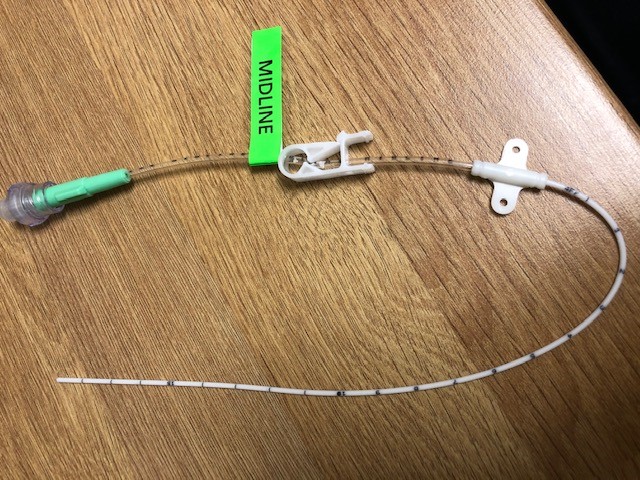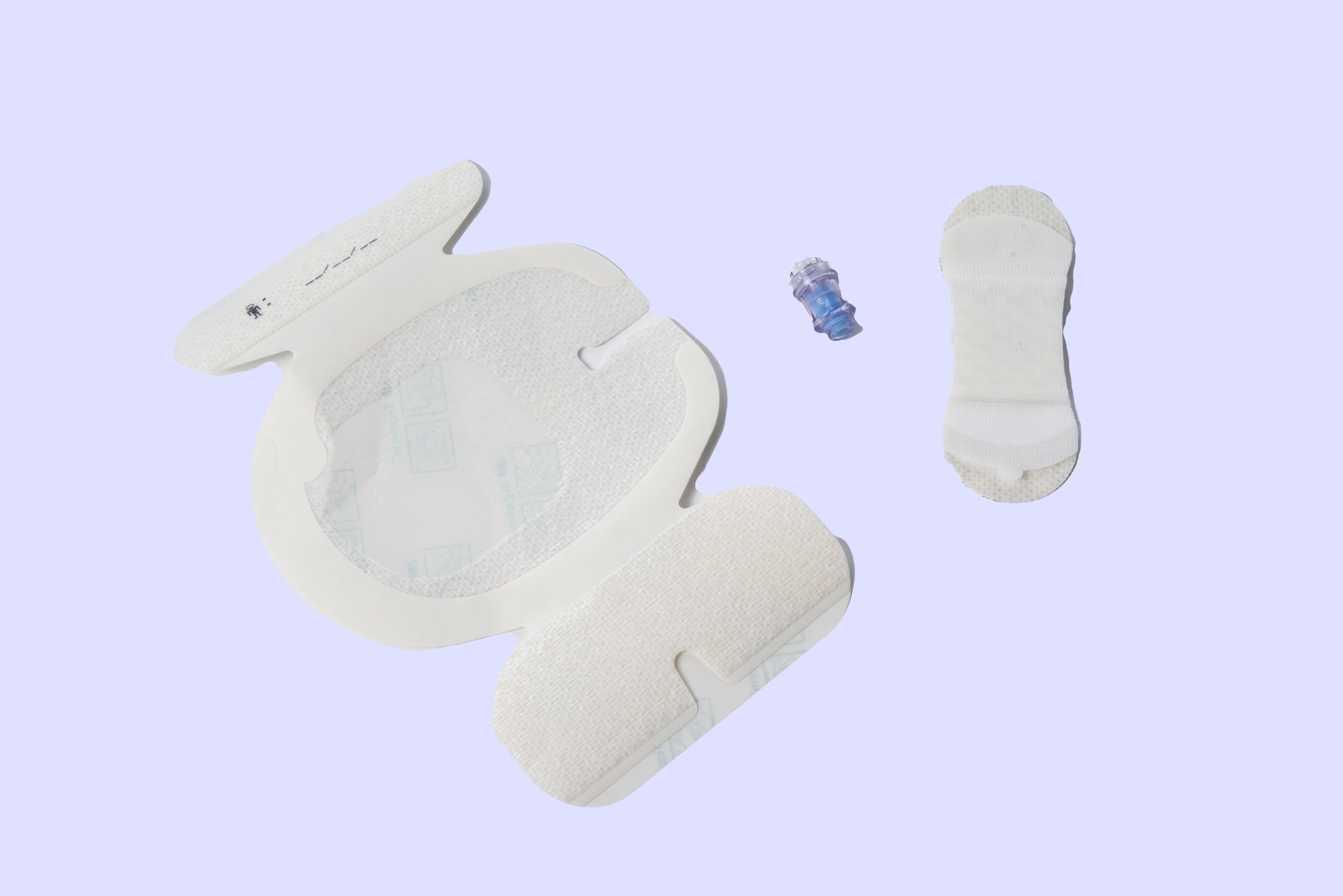Information for patients at home who need intravenous therapy through a Midline
Information for patients from the Hospital at Home Team
What is a Midline and what is it used for?
A Midline is a flexible hollow tube that is threaded over a guide-wire, and inserted into a blood vessel. The guide-wire is then removed leaving a hollow plastic tube in place. This allows drugs / fluids to be given directly into the bloodstream.
The Midline is usually placed in veins around the inside of the elbow or lower arm. Your Midline can stay in place for up to 30 days, but staff may have a valid reason for leaving the Midline in for longer.
-
 A Midline
A Midline -
 Dressing used to hold the Midline in place on your arm
Dressing used to hold the Midline in place on your arm
How will my Midline be held in place?
Your Midline is fixed to your skin with a special clear dressing. This dressing should be changed by the nursing team if it becomes soiled or loose. Additional dressings (such as bandages) may be used, and staff will remove them regularly to check the site of your Midline.
How should I look after my Midline?
Keep your dressing clean and dry, and do not touch it. Tell the nurse if your dressing becomes wet, dirty, loose, or falls off.
Protect your Midline from knocks.
Take extra care when dressing and undressing. It is advisable to wear clean loose-fitting sleeves.
Report any problems (such as pain, redness, or swelling) to the nurse looking after you.
Tell the nurse if you feel hot, cold, or shivery.
If you think you do not need the Midline any more or have any queries, please ask the nurse when they come to give you your treatment.
When can my Midline be removed?
Your Midline can usually stay in place until your treatment is finished. It will be re-positioned if it becomes red and sore, or dislodged.
When your treatment is finished a nurse will remove the Midline, which comes out easily, and will apply pressure with some sterile gauze until it has stopped bleeding. A dry sterile dressing will be placed over the exit site, and this dressing can be removed after 24 hours.
How should my Midline be cared for?
A special clear dressing will be placed over your Midline to keep the site clean. Staff will check this on a regular basis.
Before staff touch your Midline they must clean their hands.
Any connectors used to administer (give you) drugs and fluids will also be cleaned.
Before administration of any drugs or fluids, a small syringe of saline solution will be used to flush and check your Midline.
Can I have a bath and / or shower with a Midline?
Please try to keep your Midline as clean and dry as possible. If it gets a bit wet but the dressing remains in place do not worry, just tell your nurse on their next visit. If you are worried, shower sleeves are available from most chemists.
What happens if my Midline falls out?
First do not panic. There will most likely be some bleeding from the site. Apply a piece of gauze, cotton wool, or tissue to the site and press; it will take a few minutes for the bleeding to stop completely. When the bleeding has stopped, apply a plaster over the site. When the nurse next visits they will be able to arrange to insert another Midline, if one is needed.
What if the bleeding does not stop?
Keep applying pressure to the area, lift your arm above your head, and telephone the nurse on one of the numbers below.
Are there any risks or side effects?
The insertion of a Midline is normally a safe procedure; but as with all invasive procedures there are some risks.
Bruising or bleeding: as with any procedure that involves the insertion of a needle into a vein, some bruising or bleeding may occur. How much you bruise or bleed may be affected by your medical condition, or by the medication you are taking.
Blood clot: on rare occasions, a blood clot can form around the Midline.
Infection: the Midline is a direct route into your body and blood stream. Sometimes the Midline site may become infected. This may result in additional medical treatment or the removal of the Midline.
Blocked Midline: your Midline may become blocked, which will prevent it from being used. We may be able to unblock it, but if it cannot be unblocked it will need to be replaced.
Mechanical irritation of the vein (phlebitis): some patients have pain and redness along the length of the vein in which the Midline sits.
Nerve, tendon, and artery injuries: very rarely during insertion, contact may be made with a nerve, tendon, or artery near to a vein causing various degrees of injury.
Contact details
If you have any questions or concerns, please contact the Hospital at Home Team on one of the following numbers.
Between 8am and 6pm (after 6pm you can leave a message, which will be picked up the following day).
Kent and Canterbury Hospital, Canterbury
Telephone: 07973 674367Queen Elizabeth the Queen Mother Hospital, Margate
Telephone: 07771 385011William Harvey Hospital, Ashford
Telephone: 07771 384940If your call is urgent, please telephone the hospital directly on _______________ and ask the operator for whoever is covering Hospital at Home.
In an emergency, dial 999.